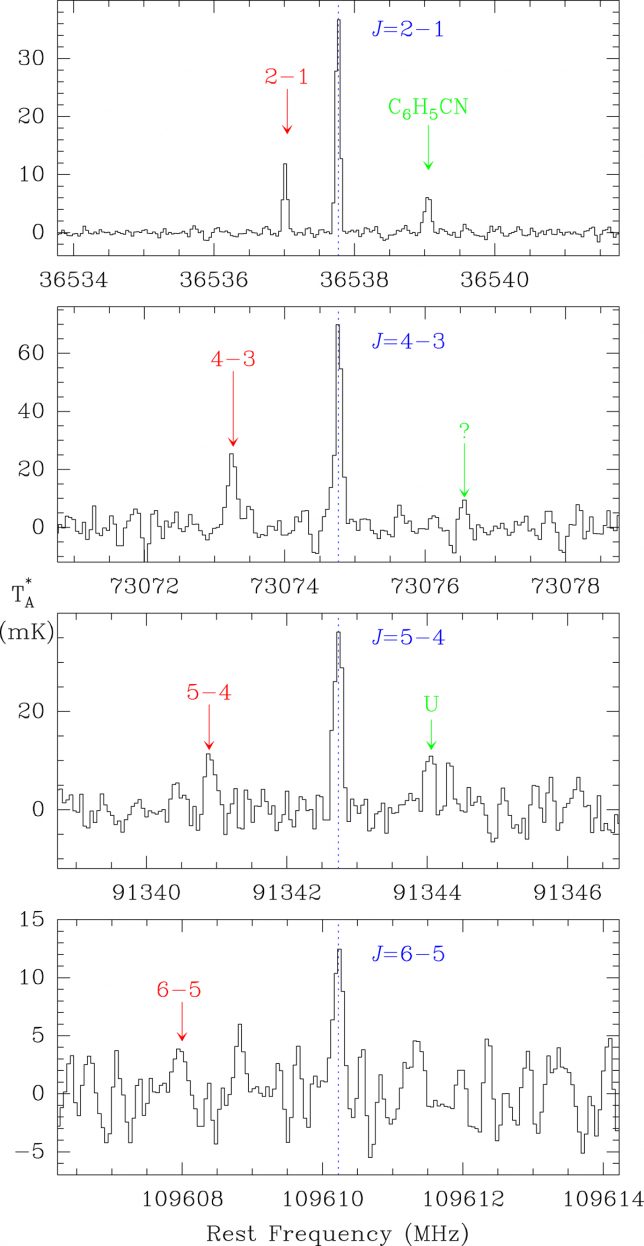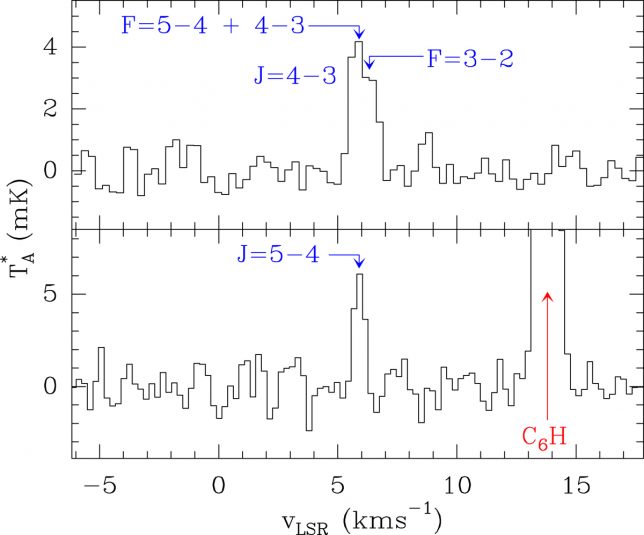
Space and laboratory observation of the deuterated cyanomethyl radical HDCCN (C. Cabezas et al., A&A, 02/2021)
- HDCCN (forest of lines) – New detection in TMC-1, laboratory production and full spectroscopically characterization of the singly deuterated isotopolog of H2CCN
- Deuteration is driven by deuteron transfer from the H2D+ molecular ion
- Further constraints on molecular formation pathways and identification of U-lines in molecular surveys

A study of C4H3N isomers in TMC-1: line by line detection of HCCCH2CN (N. Marcelino et al., A&A, 02/2021)
- HCCCH2CN (22 lines) – New detection and confirmation
- CH2CCHCN (16 lines) – New detection and confirmation
- The derived abundances suggest a common origin in the formation of the C4H3N isomers: reaction of the CN radical with unsaturated hydrocarbons methyl acetylene and allene

Discovery of the acetyl cation, CH3CO+, in space and in the laboratory (J. Cernicharo et al., A&A, 02/2021)
- CH3CO+ (8 lines) – First time detection in Space (TMC-1 and other cold dark clouds), laboratory production and characterization of the protonated form of ketene (H2CCO)
- The derived high abundance of the protonated form of ketene is due to the high proton affinity of the neutral species
- Further constraints on formation/destruction rates and/or chemical formation routes to CH3CO+
- The reaction of ketene with H3+ is the most favourable for protonation, from the thermodynamical point of view

Space and laboratory discovery of HC3S+ (J. Cernicharo et al., A&A, 02/2021)
- HC3S+ (4 lines) – First time detection in Space (TMC-1), laboratory production and characterization of the protonated form of C3S
- The spectroscopic parameters obtained for HC3S+ from ab initio calculations agree very well with that obtained from observations and in the laboratory
- Constraint in chemical formation routes: The derived C3S/HC3S+ ratio is well reproduced by a gas-phase chemical model in which HC3S+ is mostly formed through protonation of C3S and the reactions S+ + C3H2 and S + C3H3+

Tentative detection of HC5NH+ in TMC-1 (N. Marcelino et al., A&A, 11/2020)
- HC5NH+ (7 lines in Q band) – First time detection in Space
- Existence of additional formation routes at stake: Our pseudo time-dependent gas-phase chemical models of cold dark clouds underestimate the abundance of protonated molecules

Discovery of HC3O+ in space: The chemistry of O-bearing species in TMC-1 (J. Cernicharo et al., A&A, 10/2020)
- HC3O+ (4 lines) – First time detection in Space and laboratory characterization of the protonated form of C3O
- The high abundance of the protonated form of C3O, (HC3O+) is due to the high proton affinity of the neutral species
- Reactions between hydrocarbon ions and atomic oxygen probably participate in the growth of these long O-bearing carbon chains (e.g. c-H2C3O and HCCCHO)
- Existence of additional formation routes at stake: Our pseudo time-dependent gas-phase chemical models of cold dark clouds underestimate the abundance of protonated molecules

Discovery of HC4NC in TMC-1: A study of the isomers of HC3N, HC5N and HC7N (J. Cernicharo et al., A&A, 10/2020)
- HC4NC (5 lines, Q band) – First time detection in Space
- Cold molecular clouds favor the formation of metastable isomers due to their low temperatures.
- In the ejecta of AGB stars, where the temperature is higher, the presence of high-energy isomers is less favorable because chemical reactions, including isomerization, are expected to favor the most stable isomer. The same pattern is expected for isotopic fractionation

Interstellar nitrile anions: Detection of C3N_ and C5N_ in TMC-1 (J. Cernicharo et al., A&A, 09/2020)
- C3N_ (2 lines) – First time detection in the Interstellar Medium
- C5N_ (6 lines) – First time detection in the Interstellar Medium
- Derivation of new rotational constants for C5N_
- Our work definitively excludes metal-bearing species, or vibrationally excited states of other known species, as carriers for the series of lines assigned to C5N_
- The derived abundance ratios between neutral radicals CnN and their anions are very similar in interstellar and circumstellar environments
- Further constraints in the formation of CnN− anions through radiative electron attachment to CnN radicals, for which calculated rate constants differ by orders of magnitude
